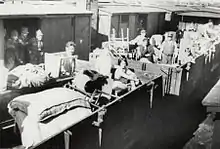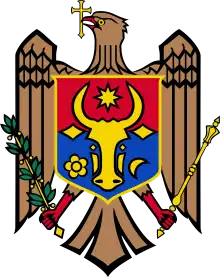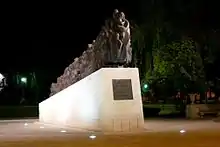Soviet deportations from Bessarabia and Northern Bukovina
The Soviet deportations from Bessarabia and Northern Bukovina took place between late 1940 and 1951 and were part of Joseph Stalin's policy of political repression of the potential opposition to the Soviet power (see Population transfer in the Soviet Union). The deported were typically moved to so-called "special settlements" (спецпоселения) (see Involuntary settlements in the Soviet Union).

| Part of a series on |
| Population transfer in the Soviet Union |
|---|
| Policies |
| Peoples |
| Operations |
| WWII POW labor |
| Massive labor force transfers |
Part of a series on the |
|---|
| History of Moldova |
 |
|
|
The deportations began after the Soviet occupation of Bessarabia and northern Bukovina, which occurred in June 1940. According to a secret Soviet ministry of interior report dated December 1965, 46,000 people were deported from Moldavian Soviet Socialist Republic for the period 1940−1953.[1]
1940–1941
As a result of the Molotov–Ribbentrop Pact of August 1939, the Romanian government was forced to accept the Soviet ultimatum of June 26, 1940, and withdrew from Bessarabia and Northern Bukovina. These regions were then incorporated into the Soviet Union, most of the former being organized as the Moldavian SSR, while the other areas were attributed to the Ukrainian SSR.
On June 12–13, 1941, 29,839 members of families of "counter-revolutionaries and nationalists" from the Moldavian SSR, and from the Chernivtsi (of Northern Bukovina) and Izmail oblasts of the Ukrainian SSR were deported to Kazakhstan, the Komi ASSR, the Krasnoyarsk Krai, and the Omsk and Novosibirsk oblasts. For the fate of such a deportee from Bessarabia, see the example of Eufrosinia Kersnovskaya. The Georgian NKVD official Sergo Goglidze, trusted henchman of Lavrenty Beria, was in charge of these deportations from Bessarabia and Northern Bukovina.[2]
Labor mobilization
During 1940 and 1941, 53,356 people from Bessarabia and Northern Bukovina were mobilized for labour across the entire territory of the Soviet Union; though the mobilization was presented as voluntary, refusal to work could result in penal punishment, and living and working conditions were generally poor.[3]
Aftermath
Professor Rudolph Rummel estimated that in 1940 – 1941, 200,000 to 300,000 Romanian Bessarabians were persecuted, conscripted into forced labor camps, or deported with the entire family, of whom 18,000 to 57,000 did not survive.[4] According to some estimates, 12% of the population of the two provinces was killed and deported.[5]
1942
On June 22, 1941, Nazi Germany, together with several other countries, including Romania (which had the primary objective of reintegrating Bessarabia and Northern Bukovina into the Romanian state), attacked the Soviet Union (see Operation Barbarossa). After the start of the war, further deportations occurred in the USSR. In April 1942, Romanian deportees and some other nationalities were deported again from Crimea and the North Caucasus. In June 1942, Romanians and others were also deported from Krasnodar Krai and the Rostov Oblast.
1949
On April 6, 1949, the Political Bureau of the Central Committee issued decision number 1290-467cc, which called for 11,280 families from Moldavian SSR to be deported as kulaks or collaborators with Nazi Germany during World War II. Ultimately, 11,239 families, comprising 35,050 persons were detained and deported on July 6, 1949, with the rest either escaping or being exempt due to their contribution to the Soviet war effort or their support for collectivisation.[6]
1951
On February 19, 1951, Viktor Abakumov delivered to Stalin a secret notice which listed the planned numbers of deported "Jehovists" from Ukraine, Belorussia, Estonia, Latvia, Lithuania and Moldova, with 1,675 persons (670 families) listed for the latter.[7] On March 3, the USSR Council of Ministers issued the corresponding decree, followed by an order of the Ministry of State Security of February 6. On March 24, the Council of Ministers of the Moldavian SSR issued the decree on the confiscation and selling of the property of the deportees. Operation North started at 4:00 am on April 1, 1951, and the round-ups continued until April 2. The deportees were classified as "special settlers".[8] In total, from the Moldavian SSR, there were 723 families (2,617 persons) deported on the night of March 31 to April 1, 1951, all members of neoprotestant sects, mostly Jehovah's Witnesses, and qualified as religious elements considered a potential danger for the Communist regime.[9][10]
Memorial
A memorial has been erected in Chișinău, close to Central Station, to commemorate the deportations.
Gallery

70 years since the first mass deportation of Bessarabians, 1941–2011. Post of Moldova 2011.  Monument to the deportees in front of the Chișinău Railway Station
Monument to the deportees in front of the Chișinău Railway Station
See also
References
- Mawdsley 1998, p. 73.
- "Nu se va întoarce nimeni și niciodată—aici vă vor putrezi oasele". newsmaker.md (in Romanian). Retrieved May 4, 2020.
- Cașu, Igor (2010). "Stalinist Terror in Soviet Moldavia". In McDermott, Kevin; Stibbe, Matthew (eds.). Stalinist Terror in Eastern Europe. Manchester University Press. p. 43. ISBN 9780719077760. Retrieved 17 January 2014.
- R. J. Rummel, Table 6.A. 5,104,000 victims during the pre-World War II period: sources, calculations and estimates, Freedom, Democracy, Peace; Power, Democide, and War, University of Hawaii.
- The Genocide of Romanians in Northern Bukovina
- Caşu, Igor (2010). "Stalinist Terror in Soviet Moldavia". In McDermott, Kevin; Stibbe, Matthew (eds.). Stalinist Terror in Eastern Europe. Manchester University Press. p. 49. ISBN 9780719077760. Retrieved 17 January 2014.
- "Recalling Operation North", by Vitali Kamyshev, "Русская мысль", Париж, N 4363, 26 April 2001 (in Russian)
- Валерий Пасат ."Трудные страницы истории Молдовы (1940-1950)". Москва: Изд. Terra, 1994 (in Russian)
- Comisia Prezidenţială pentru Analiza Dictaturii Comuniste din România: Raport Final / ed.: Vladimir Tismăneanu, Dorin Dobrincu, Cristian Vasile, Bucureşti: Humanitas, 2007, ISBN 978-973-50-1836-8, p. 754 (in Romanian)
- Elena Şişcanu, Basarabia sub ergimul bolşevic (1940-1952), Bucureşti, Ed. Semne, 1998, p.111 (in Romanian)
Bibliography
| Russian Wikisource has original text related to this article: |
- Victor Bârsan, Masacrul inocenţilor, Bucharest, 1993, pg.18-19
- Anton Antonov-Ovseenko, "The Time of Stalin", Harper and Row (in English)
- Johann Urwich-Ferry, "Ohne Passdurch die UdSSR", Editura "Gruparea Româno-Germană de studii", München, 1976 - 1978 (in German) "Fără paşaport prin URSS. Amintiri", Editura Eminescu, Bucureşti, 1999 (in Romanian)
- Mawdsley, Evan (1998). The Stalin Years: The Soviet Union, 1929-1953. Manchester University Press. ISBN 9780719046001. LCCN 2003046365.